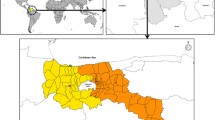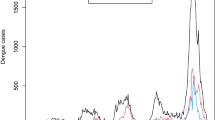Abstract
Dengue is a major international public health concern and one of the most important vector-borne diseases. The purpose of this article is to investigate the association among temperature, rainfall, relative humidity, and dengue fever by incorporating the lag effect and examining the dominant interannual model of the modern climate, the El Niño Southern Oscillation (ENSO), in the southern region of Taiwan. We built a linear Poisson regression model by including linear time treads and statistical indicators, verified with disease data in the 2004–2013 period. Here we showed that regional climatic factors in association with the interannual climate variability expressed by the ENSO phenomenon had a significant influence on the dynamics of urban dengue fever in southern Taiwan. The 2–4-month lag of statistical indicators of regional climate factors together with the 4-month lagged Pacific surface temperature (SST) anomaly in the proposed Poisson regression model could capture the regional dengue incidence patterns well. The statistical indicators of mean and coefficient of variation of temperature showed the greatest impact on the dengue incidence rate. We also found that the dengue incidence rate increased significantly with the lag effect of the warmer SST. The ability to forecast regional dengue incidence in southern Taiwan could permit pretreatment of mosquito habitats adjacent to human habitations with highly effective insecticides that would be released at the time of the high-temperature season.




Similar content being viewed by others
References
Bhatt S, Gething PW, Brady OJ et al (2013) The global distribution and burden of dengue. Nature 496:504–507
Bi P, Zhang Y, Parton KA (2007) Weather variables and Japanese encephalitis in the metropolitan area of Jinan city, China. J Infect 55:551–556
Biggs R, Carpenter SR, Brock WA (2009) Turning back from the brink: detecting an impending regime shift in time to avert it. Proc Natl Acad Sci USA 106:826–831
Brunkard JM, Cifuentes E, Rothenberg SJ (2008) Assessing the roles of temperature, precipitation, and ENSO in dengue re-emergence on the Texas-Mexico border region. Salud Publica Mex 50:227–234
Burattini MN, Chen M, Chow A et al (2008) Modelling the control strategies against dengue in Singapore. Epidemiology and Infection 136:309–319
Carpenter SR, Brock WA (2006) Rising variance: a leading indicator of ecological transition. Ecol Lett 9:308–315
Cazelles B, Chavez M, McMichael AJ, Hales S (2005) Nonstationary influence of El Niño on the synchronous dengue epidemics in Thailand. PLoS Med 2:e106
Centers for Disease Control, Department of Health, ROC (Taiwan) (2002) Statistics of communicable diseases and surveillance report in Taiwan area, 2002. http://www.cdc.gov.tw/uploads/files/201304/78dcc96b-16d3-401b-93a1-14976f022e40.pdf. Accessed 2 July 2013
Chen KT, Chou MY, Ma LS (1987) The primary investigation report of dengue outbreak in southern Taiwan. Taiwan Epidemiol Bull 3:93–95
Chen D, Cane MA, Kaplan A, Zebiak SE, Huang D (2004) Predictability of El Niño over the past 148 years. Nature 428:733–736
Chen SC, Liao CM, Chio CP, Chou HH, You SH, Cheng YH (2010) Lagged temperature effect with mosquito transmission potential explains dengue variability in southern Taiwan: insights from a statistical analysis. Sci Total Environ 408:4069–4075
Chowell G, Sanchez F (2006) Climate-based descriptive models of dengue fever: the 2002 epidemic in Colima, Mexico. J Environ Health 68:40–44
Christophers SR (1960) Aedes aegypti (L.) The yellow fever mosquito: its life history, bionomics and structure. Cambridge University Press, London
Dai A, Wigley TML (2000) Global patterns of ENSO-induced precipitation. Geophys Res Lett 27:1283–1286
Dakos V, Scheffer M, van Nes EH, Brovkin V, Petoukhov V, Held H (2008) Slowing down as an early warning signal for abrupt climate change. Proc Natl Acad Sci USA 105:14308–14312
Dakos V, van Nes EH, Donangelo R, Fort H, Scheffer M (2010) Spatial correlation as leading indicator of catastrophic shifts. Theor Ecol 3:163–174
Drake JM, Griffen BD (2010) Early warning signals of extinction in deteriorating environments. Nature 467:456–459
Earnest A, Tan SB, Wilder-Smith A (2012) Meteorological factors and El Niño Southern Oscillation are independently associated with dengue infections. Epidemiol Infect 140:1244–1251
Figueeiredo MA, Rodrigues LC, Barreto ML et al (2010) Allergies and diabetes as risk factors for dengue hemorrhagic fever: results of a case control study. PLoS Negl Trop Dis 4:e699
Focks DA, Barrera R (2007) Dengue transmission dynamics: assessment and implications for control. Report of the Scientific Working Group meeting on Dengue, World Health Organization, Geneva, pp 92–109
Gagnon AS, Bush ABG, Smoyer-Tomic KE (2001) Dengue epidemics and the El Niño Southern Oscillation. Clim Res 19:35–43
Gubler DJ (1998) Dengue and dengue hemorrhagic fever. Clin Microbiol Rev 11:480–496
Gubler DJ, Reiter P, Ebi KL, Yap W, Nasci R, Patz JA (2001) Climate variability and change in the United States: potential impacts on vector- and rodent-borne diseases. Environ Health Perspect 109:223–233
Guttal V, Jayaprakash C (2008) Changing skewness: an early warning signal of regime shifts in ecosystems. Ecol Lett 11:450–460
Hales S, Weinstein P, Woodward A (1996) Dengue fever epidemics in the South Pacific: driven by El Niño southern oscillation? Lancet 348:1664–1665
Hales S, Weinstein P, Souares Y, Woodward A (1999) El Niño and the dynamics of vectorborne disease transmission. Environ Health Perspect 107:99–102
Hales S, de Wet N, Maindonald J, Woodward A (2002) Potential effect of population and climate changes on global distribution of dengue fever: an empirical model. Lancet 360:830–834
Halstead SB (2008) Dengue virus-mosquito interactions. Annu Rev Entomol 53:273–291
Hii YL, Rocklöv J, Wall S, Ng LC, Tang CS, Ng N (2012) Optimal lead time for dengue forecast. PLoS Negl Trop Dis 6:e1848
Hu WB, Clements A, Williams G, Tong SL (2010) Dengue fever and El Niño/Southern Oscillation in Queensland, Australia: a time series predictive model. Occup Environ Med 67:307–311
Joanes DN, Gill CA (1998) Comparing measures of sample skewness and kurtosis. Statistician 47(1):183–189
Johansson MA, Dominid F, Glass GE (2009) Local and global effects of climate on dengue transmission in Puerto Rico. PLoS Negl Trop Dis 3:e382
King CC, Wu YC, Chao DY et al (2000) Major epidemics of dengue in Taiwan in 1981–2000: related to intensive virus activities in Asia. Dengue Bull 24:1–10
Kovats RS, Bouma MJ, Hajat S, Worrall E, Haines A (2003) El Niño and health. Lancet 362:1481–1489
Kyle JL, Harris E (2008) Global spread and persistence of dengue. Annu Rev Microbiol 62:71–92
Lai LW (2011) Influence of environmental conditions on asynchronous outbreaks of dengue diseases and increasing vector population in Kaohsiung, Taiwan. Int J Environ Health Res 21:133–146
Lambrechts L, Paaijmans KP, Fansiri T, Carrington LB, Kramer LD, Thomas MB, Scott TW (2011) Impact of daily temperature fluctuations on dengue virus transmission by Aedes aegypti. Proc Natl Acad Sci USA 108:7460–7465
Lei HY, Huang JH, Huang KJ, Chang C (2002) Status of dengue control programme in Taiwan—2001. Dengue Bull 26:14–23
Lenton TM (2011) Early warning of climate tipping points. Nature Clim Change 1(4):201–209
Lin CC, Huang YH, Shu PY, Wu HS, Lin YS, Yeh TM, Liu HS, Liu CC, Lei HY (2010) Characteristic of dengue disease in Taiwan: 2002–2007. Am J Trop Med Hyg 82:731–739
Livina VN, Lenton TM (2007) A modified method for detecting incipient bifurcations in a dynamical system. Geophys Res Lett 34(3):L03712
Mackenzie JS, Gubler DJ, Petersen LR (2004) Emerging flaviviruses: the spread and resurgence of Japanese encephalitis, West Nile and dengue viruses. Nat Med 10:S98–S109
Martinerie J, Adam C, Le Van Quyen M, Baulac M, Clemenceau S, Renault B, Varela FJ (1998) Epileptic seizures can be anticipated by non-linear analysis. Nat Med 4:1173–1176
McMichael AJ, Haines A, Slooff R, Kovats S (1996) Climate changes and human health. World Health Organization, Geneva
McMichael AJ, Woodruff RE, Hales S (2006) Climate change and human health: present and future risk. Lancet 367:859–869
Patz JA, Campbell-Lendrum D, Holloway T, Foley JA (2005) Impact of regional climate change on human health. Nature 438:310–317
Phillips ML (2008) Dengue reborn widespread resurgence of a resilient vector. Environ Health Perspect 116:A382–A388
Promprou S, Jaroensutasinee M, Jaroensutasinee K (2005) Climatic factors affecting dengue haemorrhagic fever incidence in Southern Thailand. Dengue Bull 29:41–48
Reiter P, Lathrop S, Bunning ML et al (2003) Texas lifestyle limits transmission of dengue virus. Emerg Infect Dis 9:86–89
Scheffer MJ, Bascompte J, Brock WA et al (2009) Early-warning signals for critical transitions. Nature 461:53–59
Scott TW, Amerasinghe PH, Morrison AC, Lorenz LH, Clark GG, Strickman D, Kittayapong P, Edman JD (2000) Longitudinal studies of Aedes aegypti (Diptera: Culicidae) in Thailand and Puerto Rico: blood feeding frequency. J Med Entomol 37:89–101
Shepard DS, Suaya JA, Halstead SB, Nathan MB, Gubler DJ, Mahoney RT, Wang DN, Meltzer MI (2004) Cost-effectiveness of a pediatric dengue vaccine. Vaccine 22:1275–1280
Su GLS (2008) Correlation of climatic factors and dengue incidence in Metro Manila, Philippines. Ambio 37:292–294
Takimoto G (2009) Early warning signals of demographic regime shifts in invading populations. Popul Ecol 51:419–426
Thammapalo S, Chongsuvivatwong V, Geater A, Dueravee M (2008) Environmental factors and incidence of dengue fever and dengue haemorrhagic fever in an urban area, Southern Thailand. Epidemiol Infect 136:135–143
Tipayamongkholgul M, Fang CT, Klinchan S, Liu CM, King CC (2009) Effects of the El Niño-Southern Oscillation on dengue epidemics in Thailand. BMC Public Health 9:422
Tsai JJ, Chan KS, Chang JS et al (2009) Effect of serotypes on clinical manifestations of dengue fever in adults. J Microbiol Immunol Infect 42:471–478
Tsai CT, Sung FC, Chen PS, Lin SC (2012) Exploring the spatial and temporal relationships between mosquito population dynamics and dengue outbreaks based on climatic factors. Stoch Environ Res Risk Assess 26:671–680
Watts DM, Burke DS, Harrison BA, Whitmire RE, Nisalak A (1987) Effect of temperature on the vector efficiency of Aedes aegypti for dengue 2 virus. Am J Trop Med Hyg 36:143–152
Wilder-Smith A, Gubler DJ (2008) Geographic expansion of dengue: the impact of international travel. Med Clin North Am 92:1377–1390
Wiwanitkit V (2006) An observation on correlation between rainfall and the prevalence of clinical cases of dengue in Thailand. J Vector Borne Dis 43:73–76
Wu PC, Guo HR, Lung SC, Lin CY, Su HJ (2007) Weather as an effective predictor for occurrence of dengue fever in Taiwan. Acta Trop 103:50–57
Yu HL, Yang SJ, Yen HJ, Christakos G (2011) A spatio-temporal climate-based model of early dengue fever warning in the southern Taiwan. Stoch Environ Res Risk Assess 25:485–494
Author information
Authors and Affiliations
Corresponding author
Electronic supplementary material
Below is the link to the electronic supplementary material.
Rights and permissions
About this article
Cite this article
Liao, CM., Huang, TL., Lin, YJ. et al. Regional response of dengue fever epidemics to interannual variation and related climate variability. Stoch Environ Res Risk Assess 29, 947–958 (2015). https://doi.org/10.1007/s00477-014-0948-6
Published:
Issue Date:
DOI: https://doi.org/10.1007/s00477-014-0948-6




